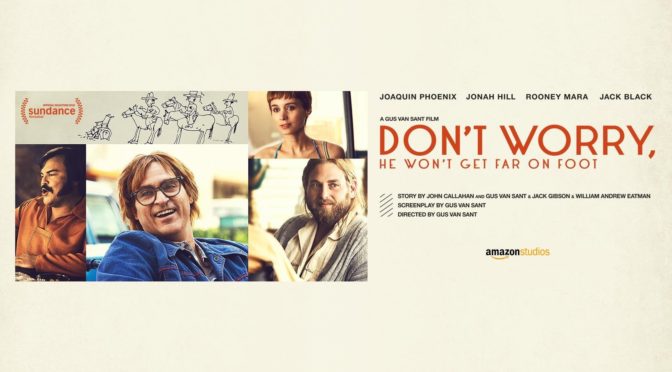After a car accident leaves him paralyzed, John Callahan (Joaquin Phoenix; Her) descends further into depression and alcoholism. His one reprieve is drawing offensive, but funny comic panels despite his limited mobility. He attends Alcoholics Anonymous meetings and asks an easygoing member (Jonah Hill; Superbad) to be his sponsor. The film is based on the true story of Callahan’s life and anyone interested should check out his cartoons which may actually be more enjoyable than the effective, but flawed movie.
Joaquin Phoenix seems to pick his roles based on how much spotlight is placed on him, the more, the better, of course. He’s not unique among actors in this regard, but his thirst for the centerstage can be distracting. His performance is dedicated and he is believably self-destructive as a depressed alcoholic, but his mannerisms are too blatant. His contorted neck, the limited use of his arms, and his labored speech become an actor’s affectations rather than genuine character traits. Sharing the screen with Phoenix, Hill is also looking for some critical attention. As a sponsor he is supportive, but his soft voice and pseudo-spiritual didactics pull him into the cliché of the wealthy, west-coast hippie. Both Phoenix and Hill turn in praiseworthy work, but do so in a way that draws too much attention to itself and distracts from the story.
Director Gus Van Sant (Good Will Hunting) has only exacerbated this issue. He appears to have sat back and let the actors lead the film rather than control their performances. There is little in the way of moderation when it comes to delivery. Instead each main actor and almost every scene is performed as a direct appeal for an award nomination. Movies can feature Oscar-worthy scenes and roles, but when they’re comprised almost entirely from them it negates the effort. When everything is at the same, almost theatrical level of emotion, it causes habituation. If the acting is constantly turned up to 11, the intended highlights no longer stand out. Truly great performances show range, not just intensity. The film desperately needs some balance between actors and the intensity of the script in order to make the climaxes impactful.
The oversaturation of emotion is also present in the visual style of the film. The cinematography is deliberately lacking in detail with a soft, almost fuzzy image intended to recall the look of 16mm film. It features an autumnal palette and the big hair and clothes of the 70s. While it is competent in achieving the look of the period, its portrayal feels one-note. The ochre hues, like the acting, are overly intense and begging for you to notice them.
There are also unexpectedly problematic production aspects. Several camera movements are amateurish as the lens clumsily crosses behind the cast during important dialogue and there are peculiar editing decisions. Van Sant intermittently uses vertical wipes between scenes that clash with the overly emotional acting and the lack of flow between scenes is at times downright sloppy. The film delivers some strong moments, but is overwhelmed by self-consciously showy acting and questionable production decisions. It works better as material for an actor’s showreel than as a complete film.

3/5 stars.
